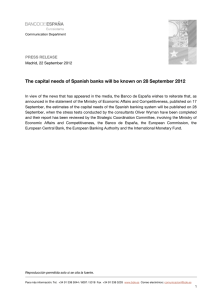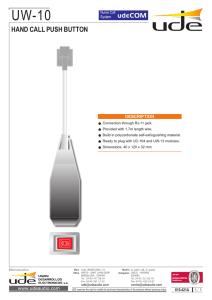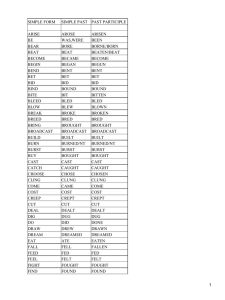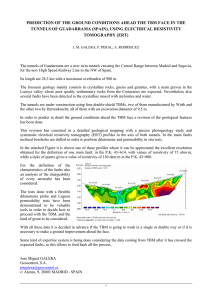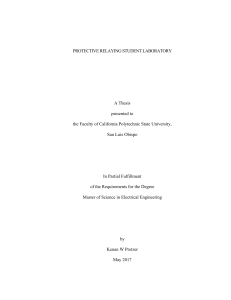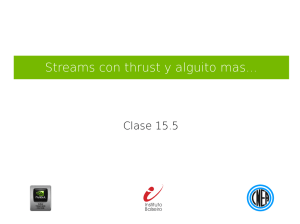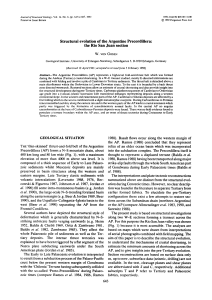northern Gibraltar Arc - Sociedad Geológica de España
Anuncio
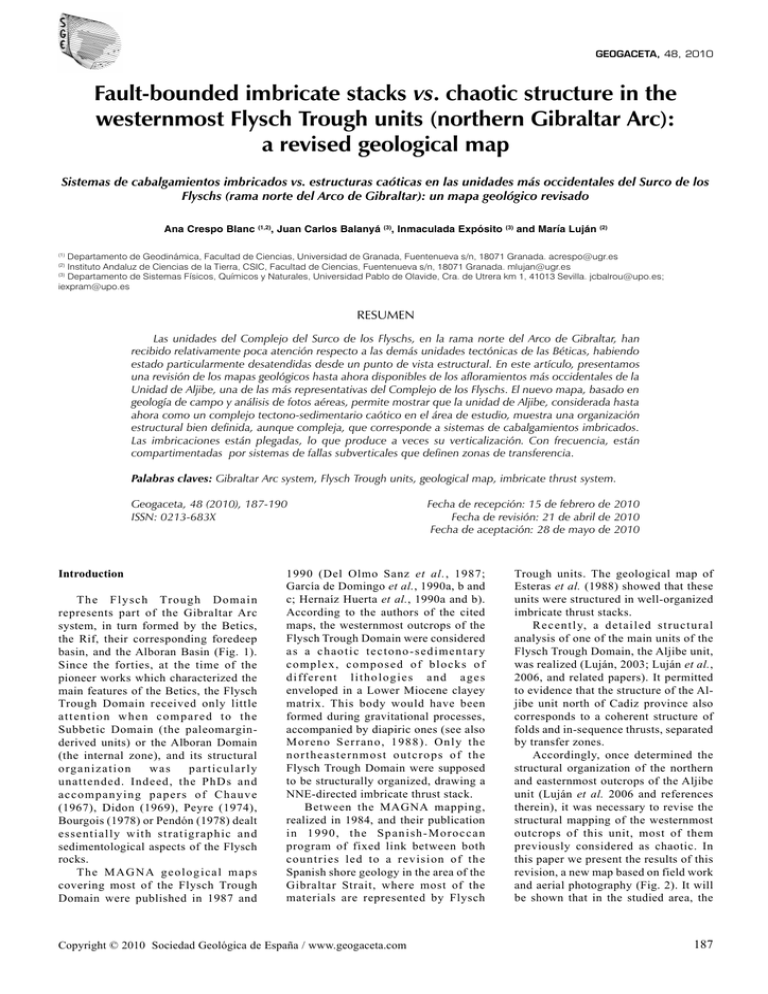
GEOGACETA, 48, 2010 Fault-bounded imbricate stacks vs. chaotic structure in the westernmost Flysch Trough units (northern Gibraltar Arc): a revised geological map Sistemas de cabalgamientos imbricados vs. estructuras caóticas en las unidades más occidentales del Surco de los Flyschs (rama norte del Arco de Gibraltar): un mapa geológico revisado Ana Crespo Blanc (1,2) , Juan Carlos Balanyá (3) , Inmaculada Expósito (3) and María Luján (2) Departamento de Geodinámica, Facultad de Ciencias, Universidad de Granada, Fuentenueva s/n, 18071 Granada. [email protected] Instituto Andaluz de Ciencias de la Tierra, CSIC, Facultad de Ciencias, Fuentenueva s/n, 18071 Granada. [email protected] Departamento de Sistemas Físicos, Químicos y Naturales, Universidad Pablo de Olavide, Cra. de Utrera km 1, 41013 Sevilla. [email protected]; [email protected] (1) (2) (3) RESUMEN Las unidades del Complejo del Surco de los Flyschs, en la rama norte del Arco de Gibraltar, han recibido relativamente poca atención respecto a las demás unidades tectónicas de las Béticas, habiendo estado particularmente desatendidas desde un punto de vista estructural. En este artículo, presentamos una revisión de los mapas geológicos hasta ahora disponibles de los afloramientos más occidentales de la Unidad de Aljibe, una de las más representativas del Complejo de los Flyschs. El nuevo mapa, basado en geología de campo y análisis de fotos aéreas, permite mostrar que la unidad de Aljibe, considerada hasta ahora como un complejo tectono-sedimentario caótico en el área de estudio, muestra una organización estructural bien definida, aunque compleja, que corresponde a sistemas de cabalgamientos imbricados. Las imbricaciones están plegadas, lo que produce a veces su verticalización. Con frecuencia, están compartimentadas por sistemas de fallas subverticales que definen zonas de transferencia. Palabras claves: Gibraltar Arc system, Flysch Trough units, geological map, imbricate thrust system. Geogaceta, 48 (2010), 187-190 ISSN: 0213-683X Introduction T h e F l y s c h Tr o u g h D o m a i n represents part of the Gibraltar Arc system, in turn formed by the Betics, the Rif, their corresponding foredeep basin, and the Alboran Basin (Fig. 1). Since the forties, at the time of the pioneer works which characterized the main features of the Betics, the Flysch Trough Domain received only little attention when compared to the Subbetic Domain (the paleomarginderived units) or the Alboran Domain (the internal zone), and its structural org a n i z a t i o n was particularly unattended. Indeed, the PhDs and accompanying papers of Chauve (1967), Didon (1969), Peyre (1974), Bourgois (1978) or Pendón (1978) dealt essentially with stratigraphic and sedimentological aspects of the Flysch rocks. The MAGNA geological maps covering most of the Flysch Trough Domain were published in 1987 and Fecha de recepción: 15 de febrero de 2010 Fecha de revisión: 21 de abril de 2010 Fecha de aceptación: 28 de mayo de 2010 1990 (Del Olmo Sanz et al., 1987; García de Domingo et al., 1990a, b and c; Hernaíz Huerta et al., 1990a and b). According to the authors of the cited maps, the westernmost outcrops of the Flysch Trough Domain were considered as a chaotic tectono-sedimentary complex, composed of blocks of d i ff e r e n t l i t h o l o g i e s a n d a g e s enveloped in a Lower Miocene clayey matrix. This body would have been formed during gravitational processes, accompanied by diapiric ones (see also Moreno Serrano, 1988). Only the northeasternmost outcrops of the Flysch Trough Domain were supposed to be structurally organized, drawing a NNE-directed imbricate thrust stack. Between the MAGNA mapping, realized in 1984, and their publication in 1990, the Spanish-Moroccan program of fixed link between both countries led to a revision of the Spanish shore geology in the area of the Gibraltar Strait, where most of the materials are represented by Flysch Copyright © 2010 Sociedad Geológica de España / www.geogaceta.com Trough units. The geological map of Esteras et al. (1988) showed that these units were structured in well-organized imbricate thrust stacks. Recently, a detailed structural analysis of one of the main units of the Flysch Trough Domain, the Aljibe unit, was realized (Luján, 2003; Luján et al., 2006, and related papers). It permitted to evidence that the structure of the Aljibe unit north of Cadiz province also corresponds to a coherent structure of folds and in-sequence thrusts, separated by transfer zones. Accordingly, once determined the structural organization of the northern and easternmost outcrops of the Aljibe unit (Luján et al. 2006 and references therein), it was necessary to revise the structural mapping of the westernmost outcrops of this unit, most of them previously considered as chaotic. In this paper we present the results of this revision, a new map based on field work and aerial photography (Fig. 2). It will be shown that in the studied area, the 187 GEOGACETA, 48, 2010 A. Crespo Blanc et al. carbonated rocks are scarce. Small outcrops formed by Upper Cretaceous to Paleocene marls and clays, attributed to the Maghrebian cover, are locally observed. Finally post-orogenic sediments are represented by Upper Miocene to Pliocene marine or costal deposits and Quaternary sediments. Main structural features of the Aljibe unit Fig. 1.- Main tectonic complexes in the western Betics. Rectangle: study area. Fig. 1.- Complejos tectónicos principales en las Béticas occidentales. Rectángulo: área de estudio. Aljibe unit shows a high organization, although complex, of folded thrust imbricates, sometimes verticalized or inverted, cut by normal faults and strike slip faults. Outcropping rock-formations in the study area In the area whose geological map appears in figure 2, the Aljibe unit comprises two well-differentiated terms. The lower one, called the «Serie de base» (Esteras et al. 1995), starts with a green-tored siltstones member followed by a sequence of calcareous turbidites alternating with siltstones, Upper Cretaceous to Oligocene in age. The outcrops of this term are generally very poor and it is very difficult to follow the boundaries between members. Sometimes, within these series, the strata more resistant to erosion (in particular, the calcareous turbidites) were used as marker (see legend of the map, Fig. 2). The upper term of Aljibe unit is represented by the characteristic quartzites and siltstones of the Aljibe formation, Aquitanian in age. In this formation it is possible to follow the strata and determine their orientation either by direct measurement in the field, or by estimation using aerial photography. Moreover, the sedimentary structures of this formation permit frequently to control the strata polarity. Locally, a Lower Burdigalian formation, composed of marls, clays and quartzitic micaceous sandstones, caps the Aljibe formation. The Subbetic Domain in the studied area is mainly represented by Triassic evaporites. Jurassic to Paleogene 188 At a first glance, the geometry of the Aljibe Unit in the study area seems to be chaotic (Fig. 2); nevertheless, it is wellorganized, although complex. It consists of various thrust slice stacks, rooted in the «Serie de base» clayey sequence. The along strike length of the imbricate stacks reaches only a few kilometres, as they are disrupted by fault zones that individualize stack segments with variable geometry and vergence. The westernmost outcrops of figure 2 (sector 1) correspond to an imbricated stack of a variable number of slices, thrust over the Subbetic Triassic evaporites and affected by a NE-SW-directed smooth fold. The orientation of the intersection between thrust plane and stratification shows that the transport direction along the thrusts varies around the folded stack, if it is assumed that transport was perpendicular to the thrust surface and bedding intersection: it is NW-directed in the northern flank, SW-directed in its eastern part and SE-directed in its southern flank. To the W, the described structures are sealed by upper Miocene deposits. The central part of the map of figure 2 (sector 2) shows a major proportion of «Serie de base» clayey materials than the Aljibe quartzites, and these latter seem to be blocks in a matrix composed by the first. Nevertheless, their areal distribution shows that all these materials are organized into various NE-SW trending thrust stacks of opposite vergence, either towards the NW or the SE, although those to the NW predominate. These are separated either by transfer faults zones and/or by corridors of Triassic evaporites. In the northeastern part of the study area (sector 3), a stack of at least seven NE-vergent thrust slices swing from a WNW-ESE direction to a near N-S one. As a whole, the stack dips steeply, and the slices can be sometimes verticalized or even overturned (cross-section 1 of Fig. 2). Finally, in the SE corner of the map (sector 4 of Fig. 2), the slices, with a high proportion of competent quartzites of Aljibe formation, are thicker than in the previous areas. They are imbricated in a verticalized or even overturned stack (cross-section 2). The whole stack draws a vertical axis fold with a half-moon shape, concave to the SE. In the central part of the arc, the most external slices show a clear vergence towards the NW, once restored to the horizontal. The southern flank of this fold is constituted by inverted slices, one of them including lower Burdigalian materials (cross-section 3). Other fault systems Faults distributed in all the study area cut the described structures. According to their direction, the faults can broadly be grouped into two sub-perpendicular systems, whose mean directions are N60E and N30W (Fig. 2). Although it is difficult to determine the dip of the faults (due to the poor outcrops and the insufficiently rugged topography), our observations indicate that most of them are steep or vertical. They generally separate the competent Aljibe quartzite formation with the clayey «Serie de base» formation, and horizontal fault separation is generally not observed. The direction of the faults belonging to the N60E system varies from N30E to N90E. The most prominent faults of this system are those which bound to the NW the half-moon like structure of sector 4. Available kinematic indicators point to a dextral strike-slip shear component for the main faults of this system. The direction of the faults of the N30W directed system varies from N-S to N50W. These faults often bound the laterals of NE-SW directed thrust stacks and underline style and/or vergence changes. In this case, they can be considered as subvertical transfer zone (in particular in sector 2). It must be stressed that some of the faults of both groups are associated with cataclastic slip bands, disposed either subparalell to the main fault surface or forming anastomosed groups (see companion paper in this volume (Balanyá et al. 2010). Discussion and conclusions The interpretation of the geological map presented in this paper shows that the Aljibe unit cannot be considered as a chaotic unit as mapped in the eighties (cited MAGNAS maps; Didon, 1969, Bourgois, 1978 and Moreno Serrano et al., 1988). By contrast, it consists of a series of thrust imbricates, eventually folded. The structuration is post-lower Geología Estructural y Tectónica Fault-bounded imbricate stacks vs. chaotic structure in the westernmost Flysch Trough units Sociedad Geológica de España 189 Fig. 2.- Mapa geológico y estructural de la zona de estudio (localización en Fig. 1) según los mapas geológicos MAGNA (ver texto para referencias), Esteras et al. (1988) y datos propios. Cortes geológicos de estructuras representativas (localizados en el mapa). GEOGACETA, 48, 2010 Fig. 2.- Geological and structural map of the study area (location in Fig. 1), according to MAGNA geological maps (see text for references), Esteras et al. (1988) and own data. Cross-sections of representative structures (localized on the map). GEOGACETA, 48, 2010 Burdigalian, the youngest affected formation. Transfer faults and late faults enhanced the supposed chaotic appearance of Aljibe unit. The structural style of Aljibe unit in the study area is very complex. The presence of Triassic evaporites as ductile substrate below the thrust imbricate can generate change of vergence within the thrust stack (e.g. see sector 2 of Fig. 2; Luján et al. 2003), but it is not sufficient to explain neither the verticalization and inversion of some thrust imbricate nor their folding with near-vertical axis (e.g. sector 4). The presence of antiformal stacks or duplex below the imbrications could have produced their verticalization by passive rotation, but the cause of the folding of the stack is now an-open-to-debate question. Smooth, N-S directed folds are observed in the post-orogenic sediments (SE of Fig. 2). These folds are post-Upper Miocene but their associated shortening is probably not strong enough to produce structures such as the halfmoon like fold of sector 4. At the moment, our working hypothesis is that the movements along lateral ramps or transfer zone can have produced such complex deformation, eventually accompained by a diapiric processes of the Triassic evaporites which could be responsible for the verticalization and/or inversion of the structures. Acknowledgements This study was supported by projects CGL2009-11384, RNM 3713, RNM 215 and CONSOLIDER - INGENIO 2010CSD2006-00041. 190 A. Crespo Blanc et al. References Balanyá, J.C., Expósito, I., Crespo-Blanc, A. and Luján, M. (2010). Geogaceta, 48, 191-194. Bourgois, J. (1978). La transversale de Ronda (Cordillères bétiques, Espagne). Données géologiques pour un modèle d’évolution de l’arc de Gibraltar, Thèse Univ. Besancon, 445 p. Chauve, P. (1967) Etude géologique du nord de la Province de Cadix (Espagne méridionale). Thèse Univ. Paris, 377 p. Del Olmo Sanz, A., de Pablo Macía, J.G., Aldaya Valverde, F., Campos Fernández, J., Chacón Montero, J., García Dueñas, V., García Rosell, L., Sanz de Galdeano, C., Orozco Fernández, M. and Torres Roldán, R. (1987) Mapa geológico de España 1:50.000 hoja 1064 (Cortes de la Frontera). IGME. Didon, J. (1969). Etude géologique du Campo de Gibraltar (Espagne méridionale). Thèse Univ. Paris. 539 p. Esteras, M., Muñoz, P. and Sandoval, N. (1988). Mapa Geológico del Estrecho de Gibraltar 1:100.000. SECEG, Madrid. Esteras, M., Feinberg, H. and DurandDelga M. (1995). IV Coloquio Internacional sobre el enlace fijo del Estrecho de Gibraltar, Sevilla. García de Domingo, A., González Lastra, J., Hernaíz Huerta, P.P., Zazo, C., Goy, J.L. and Ruiz Reig, P. (1990a). Mapa Geológico de España 1:50.000, hoja nº 1073/1076 (Vejer de la Frontera). IGME. García de Domingo, A., Hernaíz Huerta, P.P., González Lastra, J. Zazo, C., Goy, J.L. and Ruiz Reig, P. (1990b). Mapa Geológico de España 1:50.000, hoja nº 1063 (Algar). IGME. García de Domingo, A., Hernaíz Huerta, P.P., González Lastra, J. Zazo, C., Goy, J.L. and Ruiz Reig, P. (1990c). Mapa Geológico de España 1:50.000, hoja nº 1069 (Chiclana de la Frontera). IGME. Hernaíz Huerta, P.P., García de Domingo, A., González Lastra, J. Zazo, C., Goy, J.L. and Ruiz Reig, P. (1990a). Mapa Geológico de España 1:50.000, hoja nº 1070 (Alcalá de los Gazules). IGME. Hernaíz Huerta, P.P., González Lastra, J., García de Domingo, A., Zazo, C., Goy, J.L. and Ruiz Reig, P. (1990b). Mapa Geológico de España 1:50.000, hoja nº 1074 (Tahivilla). IGME. Luján, M. (2003). Estructura y cinemática de la Unidad del Aljibe (Complejo de Flyschs, Béticas): Ensayo de modelización analógica. Tesis Doctoral, Univ. Granada, 131 p. Luján, M., Storti, F., Balanyá, J. C., CrespoBlanc, A. and Rossetti, F. (2003). Journal of Structural Geology, 25, 867-881. Luján, M., Crespo-Blanc, A. and Balanyá, J.C. (2006). Tectonics, 25/6, TC600110.1029/2005TC 001910:1-17 Moreno Serrano, F., García de Domingo, A., González Lastra, J., Hernaíz Huerta, P. P. and Ruiz Reig, P. (1988). Boletín Geológico y Minero de España, 99(3), 315-339. Pendón, G. (1978). Sedimentación turbidítica en las unidades del Campo de Gibraltar. Tesis Univ. Granada. 251 p. Peyre, I. (1974). Géologie d’Antequera et sa région (Cordillères Bétiques, Espagne). Thèse Univ. Paris. 528 p. Geología Estructural y Tectónica
